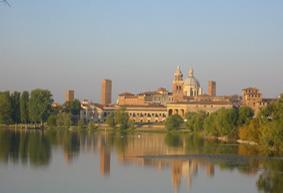


All the structures

Mantua is a province of Lombardy with over 400,000 inhabitants.
Mantua’s history is characterized by the presence of the Gonzaga family in its lands, once one of the most important families in Northern Italy. Due to their actions, Mantua managed to resist the expansion of powerful Milan to become an increasingly vibrant and cultured city.
Before the River Mincio joins the Po it forms an enchanting expanse of lake around Mantua. Surrounded by these natural features, Mantua’s art treasures will surprise you. Piazza Sordello is one of Mantua’s most important squares. The Ducal Palazzo is almost a city within the city itself, with palaces, churches and internal squares.
A walk through the city takes you to Piazza delle Erbe with major buildings such as the San Lorenzo Rotunda, the Clock Tower, Palazzo della Ragione and Palazzo del Podestà.
Among the buildings that best express Mantua’s history is Palazzo Te, the villa of Federico Gonzaga II and considered as Giulio Romano’s masterpiece.
Visit Castellaro Lagusello in the province of Mantua, a village with a small lake in the unusual shape of a heart.
Castiglione delle Stiviere is the aristocratic-looking village where San Luigi Gonzaga was born. Between Via Senigaglia and Via Cesare Battisti is the Fountain of the Three Towers, three cisterns of different dimensions covered by an arcade. The first tank was used for drinking, the second for washing clothes and the third for watering animals.
On the road towards Mantua lies Bertone Park, once used by the Gonzaga family for game hunting and today a nature oasis.
No tour of the Mantua province is complete without visiting Sabbioneta and the beautiful painted rooms and wooden statues of the Ducal Palace; also the historic ghetto and synagogue, a testimony to the Jewish culture. The Galleria degli Antichi, perhaps inspired by the Uffizi Gallery, once housed a collection of three thousand Roman sculptures, now sadly dispersed. The beauty of Sabbioneta can compete with many major Italian and European cities; despite its smaller size it is certainly of no less artistic and historical importance.